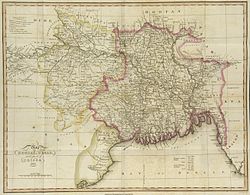Six point movement

The Six Point Movement was a movement in East Pakistan, spearheaded by Sheikh Mujibur Rahman, which called for greater autonomy for East Pakistan.[1] The movement's main agenda was to realize the six demands put forward by a coalition of Bengali nationalist political parties in 1966, to end the perceived exploitation of East Pakistan by the West Pakistani rulers.[2] It is considered a milestone on the road to Bangladesh's independence.[3]
Background
Following the partition of India, the new state of Pakistan came into being. The inhabitants of East Pakistan (later Bangladesh) made up the majority of its population, and exports from East Pakistan (such as jute) were a majority of Pakistan's export income. However, East Pakistanis did not feel they had a proportional share of political power and economic benefits within Pakistan. A statistical overview of economic discrimination is shown in this table:[4]
| Year | Spending on West Pakistan (in crore rupees) | Amount spent on West as percentage of total | Spending on East Pakistan (in crore rupees) | Amount spent on East as percentage of total |
|---|---|---|---|---|
| % of total population | 36.23 | 63.77 | ||
| 1950–55 | 1,129 | 68.31 | 524 | 31.69 |
| 1955–60 | 1,655 | 75.95 | 524 | 24.05 |
| 1960–65 | 3,355 | 70.5 | 1,404 | 29.5 |
| 1965–70 | 5,195 | 70.82 | 2,141 | 29.18 |
| Total | 11,334 | 71.16 | 4,593 | 28.84 |
| Source: Reports of the Advisory Panels for the Fourth Five Year Plan 1970–75, Vol. I, published by the planning commission of Pakistan (quick reference: crore = 107, or 10 million) | ||||
East Pakistan was facing a critical situation after being subjected to continuous discrimination on a regional basis, year after year. As a result, the economists, intelligentsia, and the politicians of East Pakistan started to raise questions about this discrimination, giving rise to the historic six-point movement.[4]
The Six Points
The six points are noted as being:[2]
- The Constitution should provide for a Federation of Pakistan in its true sense based on the Lahore Resolution, and the parliamentary form of government with supremacy of a Legislature directly elected on the basis of universal adult franchise.[1]
- The federal government should deal with only two subjects: Defence and Foreign Affairs, and all other residual subjects should be vested in the federating states.[1]
- Two separate, but freely convertible currencies for two wings should be introduced; or if this is not feasible, there should be one currency for the whole country, but effective constitutional provisions should be introduced to stop the flight of capital from East to West Pakistan. Furthermore, a separate Banking Reserve should be established and separate fiscal and monetary policy be adopted for East Pakistan.[1]
- The power of taxation and revenue collection should be vested in the federating units and the federal centre would have no such power. The federation would be entitled to a share in the state taxes to meet its expenditures.[1]
- There should be two separate accounts for the foreign exchange earnings of the two wings; the foreign exchange requirements of the federal government should be met by the two wings equally or in a ratio to be fixed; indigenous products should move free of duty between the two wings, and the constitution should empower the units to establish trade links with foreign countries.[1]
- East Pakistan should have a separate military or paramilitary force, and Navy headquarters should be in East Pakistan.[1]
Reception
The proposal was rejected by politicians from West Pakistan and non Awami League politicians from East Pakistan. It was rejected by the President of All Pakistan Awami League Nawabzada Nasarullah Khan. It was also rejected by National Awami Party, Jamaat-i-Islami, and Nizam-i-Islam.[4] The movement had the support of the population of East Pakistan.[5]
See also
References
- ^ a b c d e f g "Six-point Programme - Banglapedia". en.banglapedia.org. Retrieved 22 March 2016.
- ^ a b "Six Points and June 7, 1966". The Daily Star. 7 June 2013. Retrieved 16 January 2018.
- ^ "Historic Six-Point Day today". The Daily Star. 7 June 2012. Retrieved 16 January 2018.
- ^ a b c "The historic six-point movement and its impact on the struggle for independence". The Daily Star. 7 June 2008. Retrieved 16 January 2018.
- ^ Manik, M Waheeduzzaman. "Revisiting the significance of the historic Six-Point Movement". archive.thedailystar.net. The Daily Star. Retrieved 16 January 2018.
{{cite web}}: Cite has empty unknown parameter:|dead-url=(help)
| History of Bangladesh |
|---|
 |
|
|

